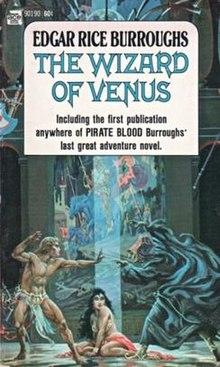
Edgar Rice Burroughs was an American author, best known for his prolific output in the adventure, science fiction, and fantasy genres. Most well-known for creating the characters Tarzan and John Carter, he is also known for writing the Pellucidar series, the Amtor series, and the Caspak trilogy.

Russell George Manning was an American comic book artist who created the series Magnus, Robot Fighter and illustrated such newspaper comic strips as Tarzan and Star Wars. He was inducted into the Will Eisner Award Hall of Fame in 2006.

Carson of Venus is a science fantasy novel by American writer Edgar Rice Burroughs, the third book in the Venus series. Burroughs wrote the novel in July and August 1937. It was serialized in 1938 in six weekly installments from January 8 to February 12 in Argosy, the same publication where the previous two Venus novels appeared. It was published in book form a year later from Edgar Rice Burroughs, Inc. Burroughs originally submitted the novel to a number of the "slick" magazines: Liberty, The Saturday Evening Post, Collier's, and Ladies' Home Journal. All rejected the story.

Sword and planet is a subgenre of science fantasy that features rousing adventure stories set on other planets, and usually featuring humans as protagonists. The name derives from the heroes of the genre engaging their adversaries in hand-to-hand combat primarily with simple melée weapons such as swords, even in a setting that often has advanced technology. Although there are works that herald the genre, such as Percy Greg's Across the Zodiac (1880) and Edwin Lester Arnold's Lieut. Gullivar Jones: His Vacation, the prototype for the genre is A Princess of Mars by Edgar Rice Burroughs originally serialized by All-Story in 1912 as "Under the Moons of Mars".

The Amtor or Venus series is a science fantasy series consisting of four novels and one novelette written by American author Edgar Rice Burroughs. Most of the stories were first serialized in Argosy, an American pulp magazine. It is sometimes known as the Carson Napier of Venus series, after its main character, Carson Napier. Napier attempted a solo voyage to Mars, but, because of mistaken navigational calculations, he finds himself heading toward the planet Venus instead. The novels, part of the sword and planet subgenre of science fiction, follow earthman Napier's fantastic adventures after he crash-lands on Venus, called Amtor by its human-like inhabitants. Unlike Barsoom, the desert planet of Mars, these stories are set upon a waterworld like Earth. Most of the events of the series take place on the island of Vepaja, the kingdom of Korva on the island of Anlap, and the city-states of Havatoo and Kormor on the tropical continent north of Vepaja.

Pirates of Venus is a science fantasy novel by American writer Edgar Rice Burroughs, the first book in the Venus series, the last major series in Burroughs's career. It was first serialized in six parts in Argosy in 1932 and published in book form two years later by Edgar Rice Burroughs, Inc. The events occur on a fictionalized version of the planet Venus, known as "Amtor" to its inhabitants.
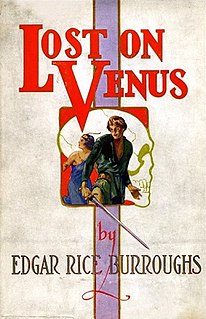
Lost On Venus is a science fantasy novel by American writer Edgar Rice Burroughs, the second book in the Venus series. It was first serialized in the magazine Argosy in 1933 and published in book form two years later.
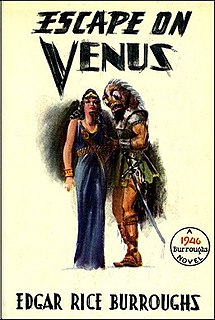
Escape on Venus is a science fantasy novel by American writer Edgar Rice Burroughs, the fourth book in the Venus series. It consists of four interconnected stories published in Fantastic Adventures between 1941 and 1942: "Slaves of the Fish Men", "Goddess of Fire", "The Living Dead," and "War on Venus". A collected edition of these stories was published in 1946.

Farewell, Fantastic Venus is a science fiction anthology edited by Brian Aldiss and Harry Harrison. It was first published in 1968 as a direct response to the information returned from the first space probes sent to Venus, especially the first atmospheric probe to return data, Venera 4. The first data was not returned from the surface until Venera 7 successfully landed in 1970.
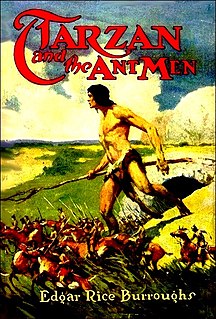
Tarzan and the Ant Men is a novel by American writer Edgar Rice Burroughs, the tenth in his series of twenty-four books about the jungle hero Tarzan. It was first published as a seven-part serial in the magazine Argosy All-Story Weekly for February 2, 9, 16 and 23 and March 1, 8 and 15, 1924. It was first published in book form in hardcover by A. C. McClurg in September 1924. The story was also adapted for Gold Key Comics in Tarzan #174-175 (1968).
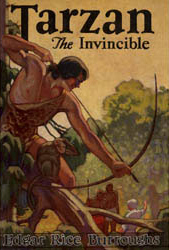
Tarzan the Invincible is a novel by American writer Edgar Rice Burroughs, the fourteenth in his series of twenty-four books about the title character Tarzan. The novel was originally serialized in the magazine Blue Book from October, 1930 through April, 1931 as Tarzan, Guard of the Jungle.
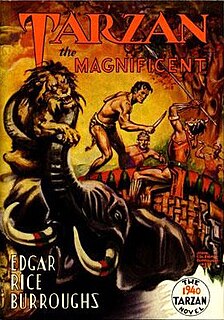
Tarzan the Magnificent is a book by American writer Edgar Rice Burroughs, the twenty-first in his series of twenty-four books about the title character Tarzan. It was originally published as two separate stories serialized in different pulp magazines; "Tarzan and the Magic Men" in Argosy from September to October, 1936, and "Tarzan and the Elephant Men" in Blue Book from November 1937 to January 1938. The two stories were combined under the title Tarzan the Magnificent in the first book edition, published in 1939 by Edgar Rice Burroughs, Inc. In order of writing, the book follows Tarzan's Quest and precedes Tarzan and the Forbidden City. In order of book publication it falls between the latter and Tarzan and the Foreign Legion. The novel's plot bears no relation to that of the 1960 film of the same title.

Tarzan and the Foreign Legion is a novel by American writer Edgar Rice Burroughs, the twenty-second in his series of twenty-four books about the title character Tarzan. The book, written June–September 1944 while Burroughs was living in Honolulu and published in 1947, was the last new work by Burroughs to be published during his life. The novel is set during World War II in Sumatra, Dutch East Indies. The term "foreign legion" does not refer to the French Foreign Legion, but is the name given in the book to a small international force fighting the Empire of Japan.

Tarzan and the Castaways is a collection of three stories by American writer Edgar Rice Burroughs, the 24th and final in his series of twenty-four books about the jungle hero Tarzan. The title novella, and the two short stories were first published in pulp magazines in 1940 and 1941. The combined book was published first as a hardcover by Canaveral Press in early 1965, and as a paperback by Ballantine Books in July 1965.

Tarzan: The Lost Adventure is a novel credited to Edgar Rice Burroughs and American writer Joe R. Lansdale, based on an incomplete fragment of a Tarzan novel, written by Burroughs, which had been left unfinished at his death. The book was serialized in four parts by Dark Horse Comics, before being published as a single volume in 1995.
Canaveral Press was a New York–based publisher of fantasy, science fiction and related material, active from the early 1960s through the mid-1970s. Richard A. Lupoff was the editor for publishers Jack Biblo and Jack Tannen.

John Carter of Mars is the eleventh and final book in the Barsoom series by American writer Edgar Rice Burroughs. It is not a novel, but rather a collection of two John Carter of Mars stories.

Forgotten Tales of Love and Murder is a collection of short stories by Edgar Rice Burroughs, edited by Patrick H. Adkins and illustrated by Danny Frolich. It was first published in hardcover in 2001 by Guidry & Adkins, a publishing partnership of Burroughs fans John H. Guidry and Patrick H. Adkins, as part of their "Tarzana Project," intended to bring into print all the author's previously unpublished or uncollected works.
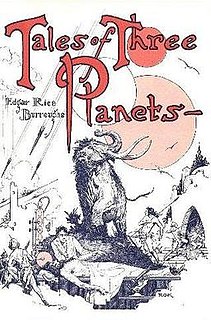
Tales of Three Planets is a posthumous collection of short stories by American writer Edgar Rice Burroughs, with an introduction by Richard A. Lupoff and illustrations by Roy G. Krenkel. It was first published in hardcover in 1964 by Canaveral Press, and has been reprinted once since.

Ulysses Paxton is a fictional character created by Edgar Rice Burroughs in his novel The Master Mind of Mars. Within the narrative framework of the novel, Captain Paxton, United States Army Infantry, is a fan of Burroughs' Barsoom series, and after having a shell blow off his legs during trench warfare in World War I, he finds himself drawn across the gulfs of space to Mars like John Carter before him. He sends Burroughs a first person manuscript of his adventures on the dying planet, which Burroughs publishes.
